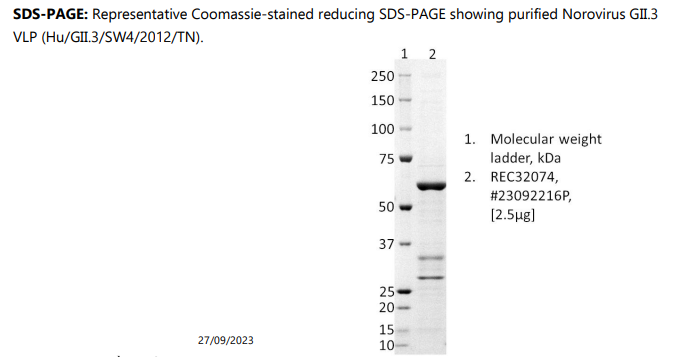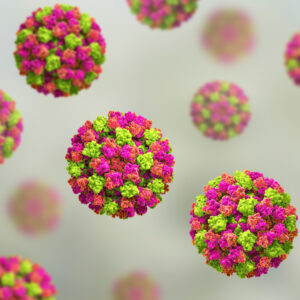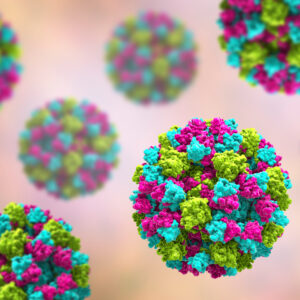Norovirus GII.3 VLP (Hu/GII.3/SW4/2012/TN)
$877.69 – $3,730.18 excl. VAT
Recombinant norovirus-like particles. Particles are formed by expression of VP1 in HEK293 cells, and are purified from the cytoplasm using a proprietary series of density gradients.
Norovirus GII.3 VLP (Hu/GII.3/SW4/2012/TN)
Recombinant norovirus-like particles. Particles are formed by expression of VP1 in HEK293 cells, and are purified from the cytoplasm using a proprietary series of density gradients.
PRODUCT DETAILS – Norovirus GII.3 VLP (Hu/GII.3/SW4/2012/TN) VIRUS-LIKE PARTICLES
- Recombinant Norovirus GII.4 virus-like particles comprising
- Expressed and purified from HEK293 cells, untagged
- Strain Hu/GII.3/SW4/2012/TN, NCBI: AJW87644.1
- Purified through isopycnic centrifugation and dialysis
- Presented as liquid in a proprietary buffer
BACKGROUND
Norovirus (NoV) is a small non-enveloped, positive-sense RNA virus belonging to the Caliciviridae family of viruses. Six norovirus genogroups have been identified to date, which are further subdivided into genotypes. NoVs have a high mutation rate and numerous genotypes have been identified. NoVs responsible for human disease are found within genogroups GII, GI and GIV. The variant GII.4 has been identified as the most common cause of Norovirus outbreaks since 2011. (Karst, S.M.).
Previously known as Norwalk virus, NoV is a major cause of non-bacterial outbreaks of acute gastroenteritis worldwide. Norovirus can infect individuals of all ages and can be a major cause of gastroenteritis in schools, care-homes, hospitals and cruise ships. Symptoms of NoV infection develop rapidly and include vomiting, nausea, abdominal cramps and diarrhoea (Robilotti, E. et al). In most cases, Nov infection is a self-limiting disease that may last 1- 3 days but can cause complications in very young, elderly and immunocompromised individuals. In some severe cases, NoV infection can result in dehydration, hospitalisation and death. (CDC).
NoV is highly contagious. It can persistent in the environment and is resistant to most household disinfectants. Transmission of NoV primarily occurs through the faecal oral route and through contact with infected individuals, contaminated clothing, surfaces, food and water. In the USA, NoV is the major cause of food related illness. (CDC).
REFERENCES
- Karst SM. (2010). Pathogenesis of noroviruses, emerging RNA viruses. Viruses.Mar;2(3):748-81. PMID: 21994656
- Robilotti E, Deresinski S, Pinsky BA. (2015). Norovirus. Clin Microbiol Rev.Jan;28(1):134-64. PMID: 25567225
- Centers for disease control and prevention: Norovirus, Clinical overview
- Centers for disease control and prevention: Norovirus, Burden of norovirus illness and outbreaks
- Takeda press release: Takeda initiates world’s first norovirus vaccine field trial




